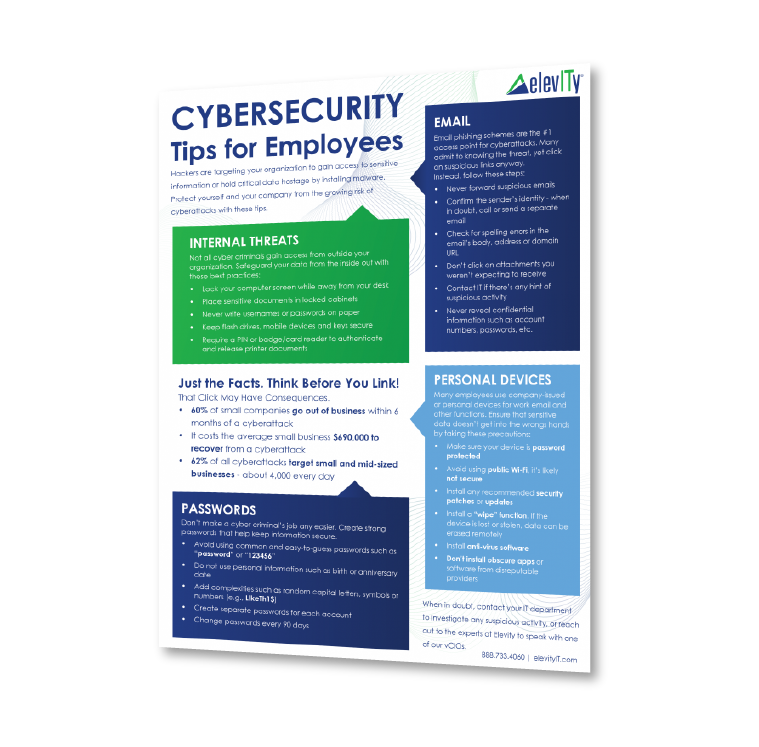It’s no secret that a lot of hackers, like many criminals, want one thing: money.
That means financial institutions are often a top target for hackers. Many industry experts have viewed cyberattacks as the contemporary version of “wild west” bank robberies. In fact, CNBC reported that U.S. banks and other financial institutions processed approximately $1.2 billion in ransomware payments in 2021. That’s almost triple the amount paid by the industry in 2020.
Hackers commonly look for ways to make a destructive impact while giving themselves a hefty payday in return. That’s why financial institutions in particular need to prepare for a potential cyberattack with the proper risk management tools in place.
Let’s go over some of the best ways to stay prepared against an attack.
Cybersecurity Best Practices
Cybersecurity is a different landscape than traditional security. As more and more information has migrated to the cloud, a lot of sensitive information — including personal data — is vulnerable to a data breach or other security incident.
Financial services companies have taken great steps to adapt and strengthen their defenses. They work around the clock to protect their data and the Personal Identifiable Information (PII) of their customers.
These steps are critical because a person’s finances can greatly affect their quality of life. If their finances are wiped out by a cyberattack, it’s catastrophic. Financial institutions have a great responsibility to protect what’s theirs and, more importantly, what isn’t theirs.
Here are eight best practices to keep in mind to reduce the cybersecurity risk at your financial organization.
- Stay current with financial cybersecurity regulations
- Empower your employees and customers
- Implement a bring-your-own-device (BYOD) policy
- Introduce 24/7 threat monitoring
- Manage third-party risks
- Assess and address weaknesses
- Have an incident response plan
- Take a holistic approach
Learn More: Can Companies Be Sued for Data Breaches?
Stay Current with Financial Cybersecurity Regulations
First and foremost, make sure that your organization follows the cybersecurity regulations for financial institutions that are designated for your sector.
For U.S.-based financial organizations this may include:
- The Sarbanes-Oxley Act (SOX)
- Payment Card Industry Data Security Standards (PCI DSS)
- Bank Secrecy Act (BSA)
- Gramm-Leach-Bliley Act (GLBA)
- Financial Industry Regulatory Authority (FINRA)
- Federal Financial Institutions Examination Council (FFIEC)
Empower Your Employees & Customers
Breaches due to social engineering are on the rise. Social engineering is a deceptive and sometimes hard-to-detect tactic hackers use. Such tactics attempt to influence a person to take actions that give them access to assets or convince someone to click a malicious link.
People’s finances are an especially big target here, as are financial companies in general. Activating a spam filter to monitor your company’s email will add an important level of security.
Uninformed people are the easiest access points for a cyberattack. Educate your employees on common phishing tactics in order to stay one step ahead of email threats. And don’t stop with employees; include cybersecurity safety tips in your eNewsletters to customers. These tips can educate them on how to protect their money and not give out their personal information to unverified sources.
Empowering employees and customers will make them active participants in blocking and reporting potential attacks. This is a vital step in strengthening your cybersecurity network.
Implement a BYOD Policy
Remote and hybrid workforces are growing, even at financial institutions. Many businesses encourage the use of personal mobile devices to access email and other apps on the go. One option you have is to implement a BYOD policy that includes guidelines on how to access company data.
Implement a Mobile Device Management (MDM) solution for smartphones and tablets. These solutions provide important software distribution, policy management, inventory management, security management and service management. An MDM solution will better secure your employees’ mobile devices in the event that a device is lost or stolen.
We also recommend a virtual desktop solution. This makes it safer for employees to use their personal computers to securely log in and work from anywhere.
Introduce 24/7 Threat Monitoring
Cybersecurity incidents can happen at any time, and that’s especially true for something as vulnerable and appealing to criminals as bank accounts and financial information. You need protection during all hours of the day, not just bankers’ hours.
In the event a hacker gains access to your network, be prepared with Artificial Intelligence (AI) based solutions. AI that’s designed to sniff out threats by detecting disruptions in data patterns will become more viable as technology advances. Early detection is key to rooting out a hacker before they have a chance to inflict major damage to your network.
Manage Third-Party Risks
Vulnerabilities in third-party software can also put your organization at risk. The global average cost of a data breach hit $4.45 million in 2023. Given that sobering statistic, you must ensure any third party you work with is reliable.
Take precautions to reduce third-party software risks. These precautions include:
- Verifying the cybersecurity protocols of your vendors
- Limiting third-party access to your critical assets
- Mandating notification if a third-party vendor encounters a breach
- Always monitoring your own network for any anomalies in data patterns
Assess & Address Vulnerabilities
Conducting regularly scheduled risk assessments can reveal potential gaps in your cybersecurity coverage. These assessments not only show where your security weaknesses lie, but are also key to determining which vulnerabilities to address first.
Have an Incident Response Plan
Breaches can happen to anyone, and certainly to an area that’s as highly targeted as the financial industry. Be prepared by having an incident response plan in place before a cyberattack hits your organization. This should be a plan with standardized methodology and reporting procedures known to your entire staff to quickly mitigate any breaches.
Take a Holistic Approach
These best practices are a great start to creating a cybersecurity plan for your financial institution. However, a complete cybersecurity plan will weave multiple best practices together for a multi-layered, comprehensive approach covering everything from cybersecurity training to incident management. Working from this holistic perspective is your best bet for a robust cybersecurity plan.
What’s Your Cybersecurity Risk Level?
Technology changes at a rapid pace. Unfortunately, hackers are usually ahead of most tech users. That means all businesses, including those the financial services industry, must make sure their IT solutions are ready to stand up against an attack.
So, how prepared do you think you are against lurking cyber threats? We’ve created a tool you can use to help pinpoint where you and your employees are with cybersecurity awareness. It’s free and only takes a few minutes to complete. Just click the Cybersecurity Risk Assessment link below, answer a few key questions and check your email for your score.





%20cropped-1.jpg)




